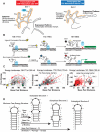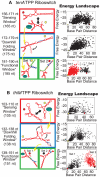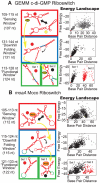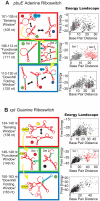Dynamic energy landscapes of riboswitches help interpret conformational rearrangements and function
- PMID: 22359488
- PMCID: PMC3280964
- DOI: 10.1371/journal.pcbi.1002368
Dynamic energy landscapes of riboswitches help interpret conformational rearrangements and function
Abstract
Riboswitches are RNAs that modulate gene expression by ligand-induced conformational changes. However, the way in which sequence dictates alternative folding pathways of gene regulation remains unclear. In this study, we compute energy landscapes, which describe the accessible secondary structures for a range of sequence lengths, to analyze the transcriptional process as a given sequence elongates to full length. In line with experimental evidence, we find that most riboswitch landscapes can be characterized by three broad classes as a function of sequence length in terms of the distribution and barrier type of the conformational clusters: low-barrier landscape with an ensemble of different conformations in equilibrium before encountering a substrate; barrier-free landscape in which a direct, dominant "downhill" pathway to the minimum free energy structure is apparent; and a barrier-dominated landscape with two isolated conformational states, each associated with a different biological function. Sharing concepts with the "new view" of protein folding energy landscapes, we term the three sequence ranges above as the sensing, downhill folding, and functional windows, respectively. We find that these energy landscape patterns are conserved in various riboswitch classes, though the order of the windows may vary. In fact, the order of the three windows suggests either kinetic or thermodynamic control of ligand binding. These findings help understand riboswitch structure/function relationships and open new avenues to riboswitch design.
Conflict of interest statement
The authors have declared that no competing interests exist.
Figures








Similar articles
-
The dynamic nature of RNA as key to understanding riboswitch mechanisms.Acc Chem Res. 2011 Dec 20;44(12):1339-48. doi: 10.1021/ar200035g. Epub 2011 Jun 16. Acc Chem Res. 2011. PMID: 21678902
-
Thermodynamic and kinetic folding of riboswitches.Methods Enzymol. 2015;553:193-213. doi: 10.1016/bs.mie.2014.10.060. Epub 2015 Feb 12. Methods Enzymol. 2015. PMID: 25726466
-
Statistical mechanical prediction of ligand perturbation to RNA secondary structure and application to riboswitches.J Comput Chem. 2020 Jun 15;41(16):1521-1537. doi: 10.1002/jcc.26195. Epub 2020 Mar 27. J Comput Chem. 2020. PMID: 32220073
-
Co-Transcriptional Folding and Regulation Mechanisms of Riboswitches.Molecules. 2017 Jul 13;22(7):1169. doi: 10.3390/molecules22071169. Molecules. 2017. PMID: 28703767 Free PMC article. Review.
-
Purine sensing by riboswitches.Biol Cell. 2008 Jan;100(1):1-11. doi: 10.1042/BC20070088. Biol Cell. 2008. PMID: 18072940 Review.
Cited by
-
Using simulations and kinetic network models to reveal the dynamics and functions of riboswitches.Methods Enzymol. 2015;553:235-58. doi: 10.1016/bs.mie.2014.10.062. Epub 2015 Feb 3. Methods Enzymol. 2015. PMID: 25726468 Free PMC article.
-
Dynamic signal processing by ribozyme-mediated RNA circuits to control gene expression.Nucleic Acids Res. 2015 May 26;43(10):5158-70. doi: 10.1093/nar/gkv287. Epub 2015 Apr 27. Nucleic Acids Res. 2015. PMID: 25916845 Free PMC article.
-
Development of an inducible anti-VEGF rAAV gene therapy strategy for the treatment of wet AMD.Sci Rep. 2018 Aug 6;8(1):11763. doi: 10.1038/s41598-018-29726-7. Sci Rep. 2018. PMID: 30082848 Free PMC article.
-
RNA graph partitioning for the discovery of RNA modularity: a novel application of graph partition algorithm to biology.PLoS One. 2014 Sep 4;9(9):e106074. doi: 10.1371/journal.pone.0106074. eCollection 2014. PLoS One. 2014. PMID: 25188578 Free PMC article.
-
Translation regulation by a guanidine-II riboswitch is highly tunable in sensitivity, dynamic range, and apparent cooperativity.RNA. 2023 Aug;29(8):1126-1139. doi: 10.1261/rna.079560.122. Epub 2023 May 2. RNA. 2023. PMID: 37130702 Free PMC article.
References
Publication types
MeSH terms
Substances
Grants and funding
LinkOut - more resources
Full Text Sources

